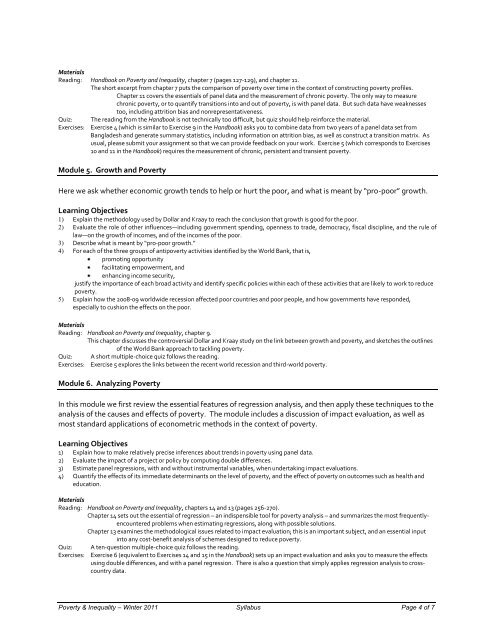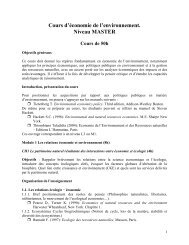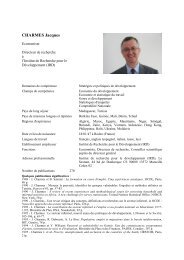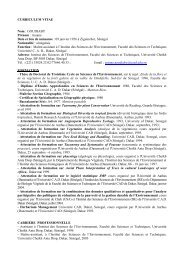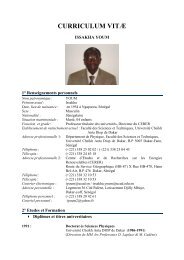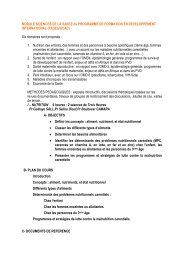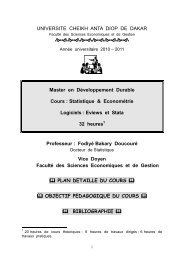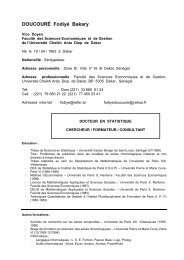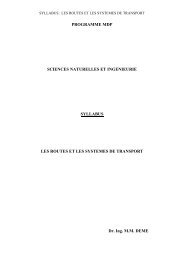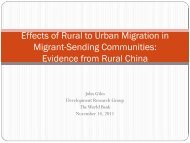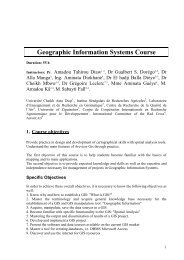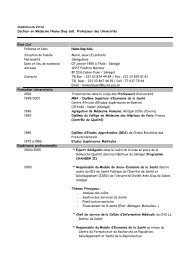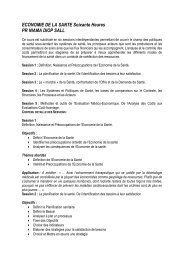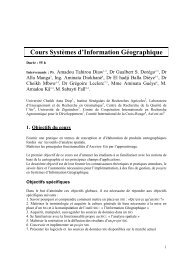Advanced Poverty Analysis - MDP UCAD - Université Cheikh Anta ...
Advanced Poverty Analysis - MDP UCAD - Université Cheikh Anta ...
Advanced Poverty Analysis - MDP UCAD - Université Cheikh Anta ...
Create successful ePaper yourself
Turn your PDF publications into a flip-book with our unique Google optimized e-Paper software.
Materials<br />
Reading: Handbook on <strong>Poverty</strong> and Inequality, chapter 7 (pages 127-129), and chapter 11.<br />
The short excerpt from chapter 7 puts the comparison of poverty over time in the context of constructing poverty profiles.<br />
Chapter 11 covers the essentials of panel data and the measurement of chronic poverty. The only way to measure<br />
chronic poverty, or to quantify transitions into and out of poverty, is with panel data. But such data have weaknesses<br />
too, including attrition bias and nonrepresentativeness.<br />
Quiz:<br />
Exercises:<br />
The reading from the Handbook is not technically too difficult, but quiz should help reinforce the material.<br />
Exercise 4 (which is similar to Exercise 9 in the Handbook) asks you to combine data from two years of a panel data set from<br />
Bangladesh and generate summary statistics, including information on attrition bias, as well as construct a transition matrix. As<br />
usual, please submit your assignment so that we can provide feedback on your work. Exercise 5 (which corresponds to Exercises<br />
10 and 11 in the Handbook) requires the measurement of chronic, persistent and transient poverty.<br />
Module 5. Growth and <strong>Poverty</strong><br />
Here we ask whether economic growth tends to help or hurt the poor, and what is meant by “pro-poor” growth.<br />
Learning Objectives<br />
1) Explain the methodology used by Dollar and Kraay to reach the conclusion that growth is good for the poor.<br />
2) Evaluate the role of other influences—including government spending, openness to trade, democracy, fiscal discipline, and the rule of<br />
law—on the growth of incomes, and of the incomes of the poor.<br />
3) Describe what is meant by “pro-poor growth.”<br />
4) For each of the three groups of antipoverty activities identified by the World Bank, that is,<br />
promoting opportunity<br />
facilitating empowerment, and<br />
enhancing income security,<br />
justify the importance of each broad activity and identify specific policies within each of these activities that are likely to work to reduce<br />
poverty.<br />
5) Explain how the 2008-09 worldwide recession affected poor countries and poor people, and how governments have responded,<br />
especially to cushion the effects on the poor.<br />
Materials<br />
Reading: Handbook on <strong>Poverty</strong> and Inequality, chapter 9.<br />
This chapter discusses the controversial Dollar and Kraay study on the link between growth and poverty, and sketches the outlines<br />
of the World Bank approach to tackling poverty.<br />
Quiz: A short multiple-choice quiz follows the reading.<br />
Exercises: Exercise 5 explores the links between the recent world recession and third-world poverty.<br />
Module 6. Analyzing <strong>Poverty</strong><br />
In this module we first review the essential features of regression analysis, and then apply these techniques to the<br />
analysis of the causes and effects of poverty. The module includes a discussion of impact evaluation, as well as<br />
most standard applications of econometric methods in the context of poverty.<br />
Learning Objectives<br />
1) Explain how to make relatively precise inferences about trends in poverty using panel data.<br />
2) Evaluate the impact of a project or policy by computing double differences.<br />
3) Estimate panel regressions, with and without instrumental variables, when undertaking impact evaluations.<br />
4) Quantify the effects of its immediate determinants on the level of poverty, and the effect of poverty on outcomes such as health and<br />
education.<br />
Materials<br />
Reading: Handbook on <strong>Poverty</strong> and Inequality, chapters 14 and 13 (pages 256-270).<br />
Chapter 14 sets out the essential of regression – an indispensible tool for poverty analysis – and summarizes the most frequentlyencountered<br />
problems when estimating regressions, along with possible solutions.<br />
Chapter 13 examines the methodological issues related to impact evaluation; this is an important subject, and an essential input<br />
into any cost-benefit analysis of schemes designed to reduce poverty.<br />
Quiz:<br />
Exercises:<br />
A ten-question multiple-choice quiz follows the reading.<br />
Exercise 6 (equivalent to Exercises 14 and 15 in the Handbook) sets up an impact evaluation and asks you to measure the effects<br />
using double differences, and with a panel regression. There is also a question that simply applies regression analysis to crosscountry<br />
data.<br />
<strong>Poverty</strong> & Inequality – Winter 2011 Syllabus Page 4 of 7


